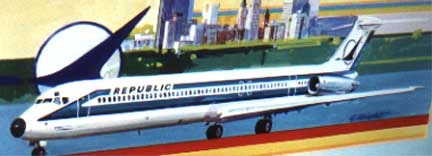That brings up the MD-80; this is the aircraft that could have been launched by Irv Teague at Airwest some five years earlier. However, in lieu of the efficient General Electric CFM-56 engine, Douglas used a derivative of the present engine on the DC-9. The aircraft was larger, and the engine was quieter and more fuel efficient than the engines on the DC-9. However, when compared to the fuel efficiency and noise levels of the CFM-56, the Pratt and Whitney JT8D-200 engine was wanting. We made our decision. Boeing would put the CFM on the 737 at a later date and, to date, have sold over 3000 aircraft.
The MD-80 was an excellent derivative of past DC-9s, an aircraft to fit the 150 seat market and the opportunity to give McDonnell Douglas an edge in this marketplace. As discussed earlier, the engine selected for the MD-80 was a poor derivative of the engine on the earlier DC-9s. To meet the noise standards set by the FAA, the engine had to initially be underpowered similar to the DC-9-50. The noise levels for takeoff were marginal, and the reduced fuel burn did not meet the levels achievable with G.E. CFM engine, which still was not being used by a manufacturer.
The two carriers that I approached with the aircraft were Hawaiian and Republic, North Centrals new name. This occurred when North Central merged and took control of Southern Airways.
Hawaiian, after an extensive analysis, purchased the earlier version of the MD-80 with the P&W; JT-8D-209 version. Their plans were to replace the DC-9-50s and ordered an initial six aircraft with options for an additional four. The airplane fit Hawaiians route structure in that all airports were at sea level and long enough to handle the MD-80. The aircraft had 172 seats, which many said made the aircraft too large for Hawaiians system. When they purchased the aircraft, the numbers seemed to prove that it could operate profitably.
Gerry Murphy, in our Airline Financial Marketing Group, spent many an hour in Honolulu working with Hawaiian on the economic viability of the MD-80 in operation in the Islands. We traveled home several times on Northwest Airlines flight that arrived in Los Angeles at about 4:30 p.m. in the afternoon. At the next gate, a DC-10 arrived from Chicago at the same time, and the airport would be full of people. On our flight home in May of 1979, we arrived but the DC-10 had not. Both Gerry and I commented and enjoyed the not so crowded airport. Only later did we find out the airplane had crashed on takeoff out of Chicago and all 278 persons were killed. I will take the crowded airport.
|
Hawaiian
Airlines MD-80
|
However, by the time the fleet of MD-80 aircraft were delivered to Hawaiian, there was a third carrier in the Islands. This was Air Pacific, started by John Higgins, ex-Executive V.P. of Hawaiian Airline, who left Hawaiian Airlines earlier.
John had also been at Hawaiian when they purchased the MD-80. John would have resisted the start of a third carrier, if he were still at Hawaiian. But this was the age of deregulation, and John was trying to compete with Hawaiian and stay in the Islands. If a carrier could get financing, they could start operation.
Air Pacific, in its initial years, did quite well but later ran into financial difficulties and transpired, leaving John without an airline and scrambling to survive.
The one thing that sticks in my mind during one of my trips to Honolulu, I had upgraded to First Class on my return flight to California to join John Higgins. This is acceptable to Douglas as it is considered a Marketing move. The problem was that when I upgraded, it bumped John out of First Class back into coach. Johns ticket was a freebie Airline Executive standby ticket. When it was determined what we had done, it was too late to reverse the process. I enjoyed the flight home.
With Air Pacific in the picture, the MD-80s were proving too large for the system, with three carriers. In addition, the engine was not holding up under the high frequency rate that the system demanded. The engine was also highly sensitive to foreign object damage. Jack Magoon was very unhappy with the aircraft and Douglas.
Republic was another challenge. Being underpowered, the aircraft could not effectively operate out of Denver. Republic did not want an aircraft with this limited capacity. They wanted to purchase the aircraft, but refused an aircraft with limitations. They were, at that time, considering the Boeing 727 to handle the limitations at Denver, and proceeded to purchase the aircraft.
Meanwhile, Pratt and Whitney was looking at a higher thrust level version of the engine on the MD-80 - inspired by my annunciation that they were near-sighted for not initially coming out with the higher thrust engine. They thought that they could not meet the noise levels required by the FAA with that engine. So after a belated start and the loss of two years and some sales, we were finally getting an engine that could perform for takeoff but still had short comings in fuel savings and noise. They were still better than the 727, and Republic purchased fourteen MD-80 aircraft with options for an additional fourteen.
 |
|
Republic
MD-80
|
When I did retire from Douglas, a friend of mine from Pratt and Whitney said that his management was glad to see me go. However, he felt that I was correct in my judgment of them. Time proved me correct.